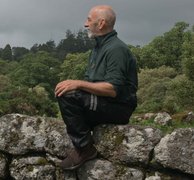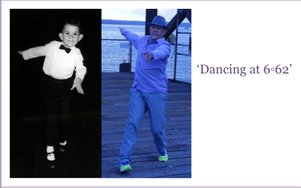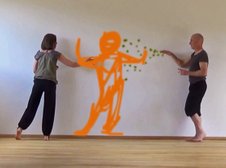g-moves
RESEARCH & Curiosities
DMP Orientations and Queer Supervision
Ongoing interest regarding Dance Movement Psychotherapy gender orientations of non-heterosexual identifying DMPs. Continued exploration of information related to practitioner life story, theoretical references, practice approach, relational engagement, and sociopolitical stories of practice-based orientations. My curiosity questions how the personal and professional integrates a practice and research methodology that does not discount the orientation of the practitioner, and hence promotes the orientation of the client.
Dancing at 6.62
An embodied performative autoethnography that explores my co-created worldview
‘Relational-biographies for an enlightened life story’
This research project explored the relational co-creation of my personal/professional philosophical perspective. Through the participation of people who have a beneficial influence on my life I explored how my way of being in the world is shaped by my life in dance and interpersonal relationships. The development of relational-biographies to elicit data provided research participants a personal manner in which to offer an account of their experience of knowing me. My autoethnographic writing process gave me greater awareness of the subtle webs of connection on which we move together, the importance of how and when we tell life stories, of reveling in the body I have now, and of my great appreciation for implicit shared learning through
interpersonal relationships. I have a renewed belief in my individuality and freedom, and in striving for my authenticity with all people.
Through this research process I came to realise my need for greater awareness and activation of a more socio-political stance in relation to equality. I am now more aware of my own relational and socio-political ideologies and how these shape my relationships with clients, colleagues and students of dance movement psychotherapy. My beliefs are not necessarily those of others so I remain attuned to and resonant with tensions in the subtle web of connections on which we move together … I have a desire to tell you of the metaphor of a pinch of skin, and the potential impact this has on us individually or collectively. A pinch, an action, or a word has the propensity to cause great harm and suffering or great delight, so I remain mindful of my actions and words in all our relationships. I hold in mind the precariousness of facing each other when we stand on the edge of our boundaries. Surrounding these tensions is my endeavour to champion our individuality, to stand tall with our flags of independence and liberty and freedom of expression.
This embodied research process has taught me more about my body and the movement I inhabit every-day in movement relationships and improvisations. The body I have now is something to be honoured so I continue to revel in my moving and improvisational interactions with people and the environment around me. I have come to a greater appreciation and respect for the delicate and multiple connections I have with people and the world around me that form the bones, flesh and skin of the life I live.
Ripples of Resonance
An exploration of improvised collaboration in the formation of a co-working relationship in clinical practice. Lingering in the action to stretch the possibilities
of what might be when we consider different perspectives to bring greater awareness to dance movement psychotherapy and embodied practice. Catching one
another falling, falling into relationship, yielding to falling, balancing on one's own and with each other, using all our senses in the co-creation of meaning.
In collaboration with Céline Butté - https://heartofmovement.com/
PUBLICATIONS
- Unkovich, G. (2023) Metaphoric synchrony in the development of an outdoor dance movement psychotherapy practice,Body, Movement and Dance in Psychotherapy, DOI:10.1080/17432979.2023.2205464
Abstract - This paper discusses the development, and frame of reference, for an intersubjective outdoor dance movement psychotherapy practice. Developing outdoor practice has raised my awareness, skills, understanding and application of nature-based interventions that support one-to-one DMP sessions with thriving human and more than-human ecological relationships. Key themes discussed as elements of practice are symbiotic relationships, cross-fertilisation of ideologies, sentient and animate reciprocity, earthly ethics, and metaphorical processes. The benefits of nature-based experiences for the embodied processes are exemplified in the therapeutic synchrony and outcomes of an allegorical client’s process. An additional positive outcome for clients is the significance of the outdoor safe space being a resource the client can return to without the therapist.
- Unkovich, G. (2022) 'Dancing at 6:64. Relational-biographies for philosophical clarity of a dance movement psychotherapist' in Body, Movement and Dance in Psychotherapy, DOI:10.1080/17432979.2022.2036235 weblink: https://doi.org/10.1080/17432979.2022.2036235
Abstract - This article discusses the relational co-creation of a dance movement psychotherapist’s (DMPs) philosophical perspective. Through participation of people who have a beneficial influence on my life I have explored how my way of being as a DMP is shaped by my life in dance and interpersonal relationships. The development of relational-biographies to elicit data offers a unique perspective that may be valuable for other embodied practitioners and students to gain clarity on their philosophical and theoretical frames of reference. My autoethnographic writing process has given me greater awareness of the subtle webs of connection on which we move together, the importance of how and when we tell life stories, of revelling in the body I have now, and of my great appreciation for implicit shared learning through interpersonal relationships. This philosophical shaping provides a more coherent inter-relational frame of reference for my dance movement psychotherapy practice, teaching and supervision.
- Unkovich, G. (2018) ‘Orientating myself: a gay dance movement psychotherapist’s gender experience in training and practice’ in Body, Movement and Dance in Psychotherapy, DOI:10.1080/17432979.2018.1491415 weblink: https://doi.org/10.1080/17432979.2018.1491415
Abstract - This paper offers a subjective account of the struggles and pleasures of being a gay dance movement psychotherapy (DMP) lecturer and therapist. The author shares stories of how this individual reality is informed by his life experience as a gay child and man. This gay intersubjective perspective of embodied therapeutic relationships posits a queer theory outlook that deviates from other DMP and embodied perspectives. The intention is to invite more critical reflection on diverse sexual and gender experience and relationships in the training and therapy space, in the hope of opening the door to more transparency with sexual orientation and gender diversity in the body, movement and dance in psychotherapy professions.
‘… I am reminded of the richness and gratitude I have for my professional relationships and for the time and space in my work and supervision where I can strive to be the man I need to be. This autoethnographic research process has brought to the foreground integral personal and professional experiences and constructs that give me greater insight into my orientation and into the impact of this on therapeutic relationships. I know that by sharing these words and some of the intimacies of my mind and embodied practice the ground on which some of us meet will have changed. As Ahmed (2006) says ‘It is by understanding how we become orientated in moments of disorientation that we might learn what it means to be orientated in the first place’ (p6).’
- Unkovich, G., Butté. C. & Butler, J. (eds) (2017) Dance Movement Psychotherapy with People with Learning Disabilities: Out of the shadows, into the light. London: Routledge
‘As dance movement psychotherapists working with people with learning disabilities we seek to create, open, hold and nurture a space where our clients can experiment with different ways of experiencing and expressing themselves, where we can all explore and learn through the gritty uneasiness of enlivened relationships. What is it like to be human in this world and to find a place in this world with all that we are?’ (preface)
‘Together we shape and reshape, form and transform, opening up possibilities in ourselves and each other that welcome, celebrate and hold sensitively the uniqueness of each of us. With curiosity, we open up to the breadth of what being alive and of interacting safely with each other actually means, looks like and sound likes … Context, intention and experience are key in how practitioners hold their embodied responses to what their clients present; always returning to be of service to the self-actualisation of each individual they work with, fostering an empowered, enlivened and responsible dialogue that ultimately will benefit all … Coming from the body, we view movement and postural positioning as a vital form of self-expression (p150).
- Unkovich, G. (2017) ‘Men shaping men. Gender discoveries in a dance movement psychotherapy men’s group’ in Unkovich, G., Butté. C. & Butler, J. (eds) Dance Movement Psychotherapy with People with Learning Disabilities: Out of the shadows, into the light. London: Routledge. (pp 121 – 135)
‘This study is shaped around a group of men whose identities are impacted by a context where the biggest daily focus can be high physical and practical support needs, in preference to supporting individuality within a broader socio-cultural and sexually constructive framework (Wilson et al., 2011). From my experience this socially oppressive context reflects a broader socio-political context, where society continues to struggle with acceptance of difference by not managing to offer equality of service for those less able to protest.
Literature confirmed that topics of sexuality and/or sexual orientation of men and women with a learning disability can be marginalised aspects of their lives that remain unrecognised and undefined by the individuals themselves (Hollins and Sinason, 2000; Leutar and Mihokovic, 2007). Negative attitudes towards sexual expression and uncertainty about gender and sexuality (Bedard et al., 2010; Noonan and Gomez, 2010) from the wider population mean that the human rights of people with a learning disability are being denied (McCarthy et al., 2012; Wilson et al., 2011). Speaking about gender identity and sexuality can still be taboo in many contexts and even more so when talking about people with a disability who may be infantilised, asexualised and/or denied their gender identity (McCarthy et al., 2012; Rembis, 2010; Swango-Wilson, 2010; Wheeler, 2007). Service users’ different levels of knowledge, experience, attitudes and feelings about sexuality and gender (Yacoub and Hall, 2009) led me to support clients in knowing more about their self-identity, so they are more able to consider informed and acceptable risks (McCarthy et al., 2012; Sinason, 1992) in their search for intimate and/or interpersonal relationships. Greater understanding of informed and acceptable risk includes awareness that the possibility of sexual exploitation and abuse exists (Cuskelly and Bryde, 2004; McCarthy et al., 2012; Swango-Wilson, 2010; Yacoub and Hall, 2009). It is important to note that, while affirming the positive elements of clients’ masculinity (Wilson et al., 2010) it is also essential to acknowledge behaviour that may damage or challenge relationships. My experience with society’s struggles to accept my gendered sexual orientation, and power struggles in personal relationships, have made me believe that it is essential to provide focused therapeutic support for those who find themselves facing similar challenges. Integrating this focused therapeutic support with guidance, related to experiences of power in relationships, empowers individuals to explore and safely express their gender identity and sexual issues in the wider context. (pp121-122)
- Butté. C., G. Unkovich., & D. Whelan. (2012) ‘Turning, listening, moving closer, as you speak, when you dance’. Arts Therapies for adults with profound and complex needs in P, Lacey (ed) ‘Life is for Living’ PMLDLink Journal Spring 2012
- Unkovich, G. (2010) ‘Time to Expand: A Tale of Two Acts’ in T, French & C, Frizell (eds) e-motion ADMP UK Quarterly Vol XX No.3 Autumn 2010
https://admp.org.uk/about-us/e-motion/
‘The further we rode the expanse of the sky and power of the mountains made me remember how small we are in relation to the planet on which we live and the universe in which that is located. We stayed for a few days in a secluded house in a small dry river valley. The river had not been as dry in the previous weeks as water ripping through the karoo had torn apart the dirt road constructed out of the natural landscape. This reminded me of the power of nature which embraces us all and that environmental action diminishes humankind’s engineering capacity to control or manipulate the environment. Humanity’s insistence on attempting to claim the land, the air, and the sea for our benefit is inconsequential when the full force of nature is apparent. Walking became the mode of transport in order to meet our basic needs; as we carried by hand all that was needed for the first night. The remaining provisions were left in vehicles four kilometres from the house. The encumbrances with which we burden ourselves needed to be shed and left aside. This brought to consciousness the extravagance we deem as necessary to survive. Carrying only what is essential is the reality in the end. Stripping ourselves of the accompaniments to a city lifestyle brings to consciousness the realisation that our time together is all about relationship and communication; relationship and communication with one another and with the flora, fauna, earth, air, sky and sea. Devoid of electric light true night surrounded us and played trickery on perceptions of the body moving in space. Sound, texture and shadow came to the fore as ways of assessing the space in which to move and relate. In sharp contrast dawn brought a searing light that stretched into the karoo and to the mountains beyond. The dry riverbed was a place for exploration and witness to the power of water on land, where trees, shrubs, and rocks had been displaced forming new channels in the semi-arid landscape. Rocks became viewing platforms, stages on which to convene with the natural environment, stages on which to move and respond to space, light, sound, and shape. I wondered if my movement could be seen or heard in the vast landscape! What impression do I make as I express myself to the world around me…’ (pp7-11)
- Butté. C. & G, Unkovich. (2009) ‘When disabilities disappear. Foundations of Dance Movement Psychotherapy practice in Profound and Multiple Learning Disabilities’ in T, French & C, Frizell (eds) e-motion ADMP UK Quarterly Vol XIX No 2.
https://admp.org.uk/about-us/e-motion/
‘Coming from a place of curiosity regarding our practice with non-verbal clients, we have reflected on our own perceived learning and physical disabilities … In this paper, we bring to light and put some words on what may be one of the most non-verbal psychotherapeutic relationships. We acknowledge how our clients may be perceived in society, and the implication of having a PMLD diagnosis. We name the dichotomy between the subjectivity and authority inherent to our role as DMPs, and our intention to be curious and open to our clients’ unique way of expressing themselves. Recognising these positions and locating our practice within a social constructionist framework we identify tools and techniques which inform our work. Movement improvisation offers us a means to ground our practice within current dance and psychotherapeutic theory. Considering breath as a vital and natural life giving experience inherent to all beings, we reflect on our roles as DMPs with this client group, particularly on the therapist’s choices in his/her relationship with adults with PMLD … This movement … form demands our moment-by-moment responses, which includes the sensations, emotions, ideas, and fantasies of the moment which are present in our internal environment. When we improvise, our attention is anchored firmly in the here and now. There are no judgements about what is good or bad, and there are no mistakes … As psychotherapists we maintain open pathways between movements and sounds, movements and words, and welcome this expression as part of the improvised interaction with clients. We acknowledge that everyone engaging in the therapy session – therapists and clients – may, can, and should use all their skills, however different they may appear … discussion and moving together … allows each of us, therapists and clients, to trust the moment and each other so that we are more frequently able to experience moments when our disabilities disappear. (pp25-33)
- Unkovich, G. (2008) ‘Thank you – I will have my body back now’ in T, French & C, Frizell (eds) e-motion ADMP UK Quarterly Vol XVIII No 4. Winter 2008
https://admp.org.uk/about-us/e-motion/
‘I wish to share a somatic experience as a way of highlighting the need for self-care when we work so intuitively, purposefully, or empathically with our bodies in inter-action. My body has been the prevailing instrument of my personal and professional life for thirty-four years, although my body’s journey in creative movement began many years before that. I began dancing at the age of six so have been ‘on the move’ now for forty-five years. This incessant motion has led me through multifaceted voyages of discovery in my personal and professional life that give substance to a life story in the creative art of dance … My new supervisor provides space to allow my body to be heard and not to be overruled by my mind; space to allow my breath to be heard as I intentionally re-cover my body. My friends and family are a phone call away; there are emails, and cards, and letters, and gifts and photos to strengthen our thoughts and memories. There is the world around me to breathe in audibly, aurally and visually, and the earth to touch and hold. My re-covered self feels stronger and lighter, and has space to breath as I move in relation to all that is around me.’ (pp6-9)
- Unkovich, G. (2006) ‘Action Empathy or Empathic Movement?’ in T, French & C, Frizell (eds) e-motion ADMT UK Quarterly. Vol. XIV No. 17. Autumn 2006
https://admp.org.uk/about-us/e-motion/
- Unkovich, G. (2005) ‘What are the perceived implications of male dance movement psychotherapists’ gender experience in Britain?’ Unpublished MA Dissertation, University of Roehampton



